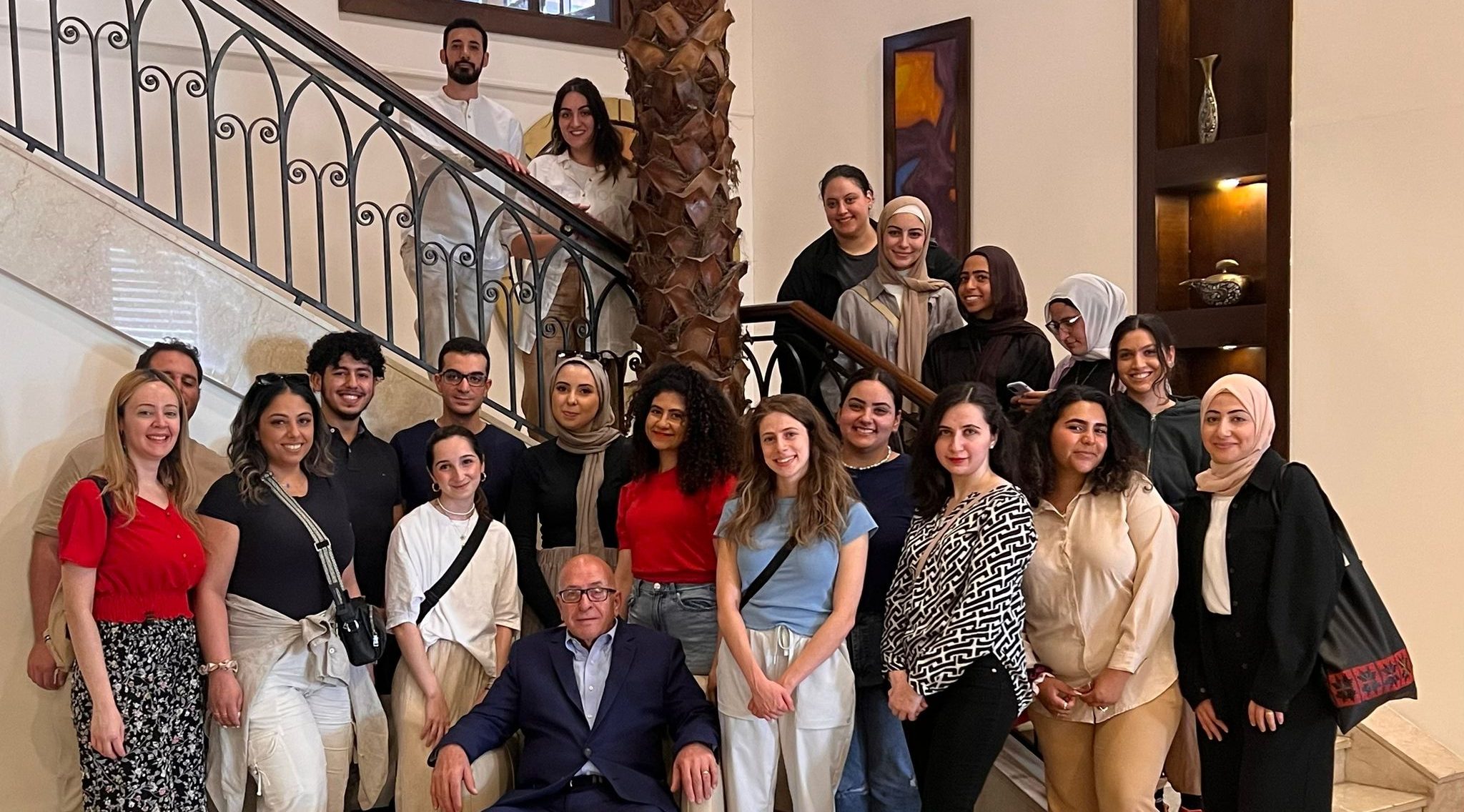Know Thy Heritage Leadership Initiative Day 6: Journey Through Jerusalem’s Divided Quarters

By Reem E.
We began our adventures in Jerusalem at the Lion’s Gate, where we met with the Al-Aqsa tour guide. The mark of approaching the Al-Aqsa grounds was the presence of armed Israeli soldiers before the arched entryway. After a while of waiting and phone calls from the soldiers to those above them in the hierarchy, we were finally let into the holy grounds. When will we enter Al-Aqsa freely without needing permission from the occupier?
Once inside, there were men who suggested skirts for some girls on our delegation to cover modestly as is required in the holy grounds of Al-Aqsa by the Al Waqf people who represent and follow the Jordanian standards since Jordan is the custodian of these holy grounds.
The tour guide began to tell us the history of Al-Aqsa, how large the area is, and the Islamic significance of the land based on specific incidents and sayings from the life of the Prophet Muhammad (pbuh).
 We walked in the general direction of the Dome of the Rock. The gold dome captured everyone’s attention as people began to take the iconic photo of themselves with it. While inside, we heard about its unique and symbolic Ummayad architecture: 12 columns for 12 months of the year, four doors for four seasons, 52 windows for 52 weeks of the year, and 24 arcs for 24 hours of the day.
We walked in the general direction of the Dome of the Rock. The gold dome captured everyone’s attention as people began to take the iconic photo of themselves with it. While inside, we heard about its unique and symbolic Ummayad architecture: 12 columns for 12 months of the year, four doors for four seasons, 52 windows for 52 weeks of the year, and 24 arcs for 24 hours of the day.

We saw the rock inside the dome from which it is believed that Prophet Muhammad (pbuh) ascended to the heavens. A fence surrounded the rock to prevent access to it. In the past, people would try to break parts of it and take it with them due to the holiness of the rock.
We made our way to the Qibla mosque, where praying Palestinians were attacked in the holy month during prayer this past Ramadan. We saw the marks of bullets and the structural damage Israelis had inflicted upon the place of worship, not even sparing a sacred place of worship—which they wish to claim for themselves—from their terroristic violence!
We also heard about the Christian history of the holy Dome of the Rock and Qibla mosque. The Qibla mosque had a church window that still stands to the present day; the rock inside the Dome of the Rock had crosses on the fence surrounding it that no longer stood.
After exiting the holy grounds, we walked towards the Jewish Quarter to see the Western Wall and its worshippers from very far away, as we were not allowed to enter. After that, we walked through the old city and saw the modern shops selling Palestinian foods as their own—falafel, hummus and other such foods. We saw a lively and well-to-do area full of Jewish families of seemingly European descent.
They stared at us and our tour guide as he spoke in his naturally loud voice about the struggles he faces in the home he and his family have rented for over 100 years. He faces constant threats to be expelled due to the lack of a lease document proving his claim to the property.
We visited the Church of the Holy Sepulchre, where we saw what is revered as Jesus’ anointment slab, his tomb and the place from which he rose.
 Like all Palestinians, our tour guide was most hospitable and took us to his home in the Muslim Quarter, where a surveillance camera exists across from the entrance of his home. He sarcastically told us to wave to the ever-watching camera before we entered his house. This camera was the reason he got fined for renovating his home without a permit, as it captured the evidence of him bringing renovation materials into the house. Obtaining a permit from the government to remodel his home is much more expensive than the price of the renovation itself. As such, he had no choice but to take the less costly risk and renovate it without a permit. As a result, he spent 48 hours in prison. He is also in constant threat of being kicked out of his home. Although he legally holds Jerusalem travel documents, he is listed as a Jordanian there, and the document expires very often and requires renewal to maintain the right to live in his homeland!
Like all Palestinians, our tour guide was most hospitable and took us to his home in the Muslim Quarter, where a surveillance camera exists across from the entrance of his home. He sarcastically told us to wave to the ever-watching camera before we entered his house. This camera was the reason he got fined for renovating his home without a permit, as it captured the evidence of him bringing renovation materials into the house. Obtaining a permit from the government to remodel his home is much more expensive than the price of the renovation itself. As such, he had no choice but to take the less costly risk and renovate it without a permit. As a result, he spent 48 hours in prison. He is also in constant threat of being kicked out of his home. Although he legally holds Jerusalem travel documents, he is listed as a Jordanian there, and the document expires very often and requires renewal to maintain the right to live in his homeland!
After a nice, fresh maklouba meal for lunch, we heard from a Muslim religious leader about Jerusalem. After this, the real adventure began in the streets of Al-Quds, buying and doing our best to bargain as clear tourists, no matter how much we wished to hide it.

A memorable moment in the day was during the Old City tour when another tour guide in the Jewish Quarter mentioned the four quarters, briefly described each, and defined the Muslim Quarter as being “total chaos.” That tour guide evidently had a pro-Israel narrative to talk in that manner and completely disregarded all the brutal realities the Muslim Quarter suffers from and did not mention anything about Christian Palestinian suffering either.
Another painful observation was the presence and prevalence of armed soldiers at every entry point to the holy grounds. Muslim places of worship are known for their open doors and lack of armed people because it is believed that such sites do not need security. If in need of security, it is to protect against fanatic Islamophobes. What does the Israeli Defense Force need to be doing at a Muslim holy site? Why must they approve who is allowed and who is not allowed into the sacred grounds?
It is as though Israel stations its armed soldiers to make their fable of being a just and attacked democracy a reality. Time will tell whoever does not know the truth. Palestinians say that a person who stole something is always on edge. Such is the case of Israel, who stole an entire land, killed and expelled its people, and then took the people’s food and culture as their own in what is defined as cultural appropriation.




